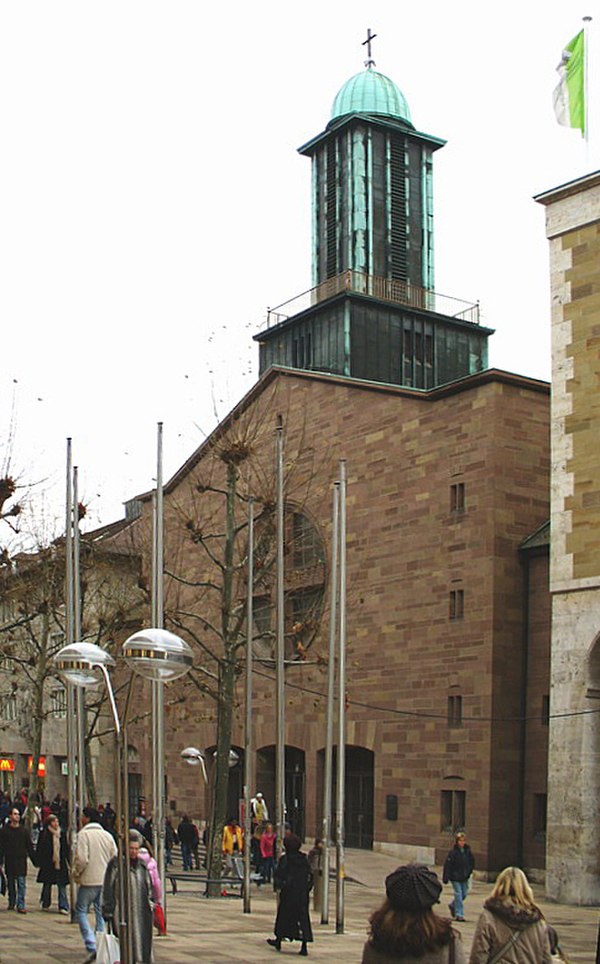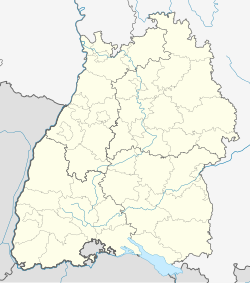Top Qs
Timeline
Chat
Perspective
Stuttgart Cathedral
Church in Baden-Württemberg, Germany From Wikipedia, the free encyclopedia
Remove ads
Stuttgart Cathedral or St Eberhard's Cathedral (Domkirche St. Eberhard, previously Stadtpfarrkirche St. Eberhard) is a church in the German city of Stuttgart. It is dedicated to Saint Eberhard of Salzburg. Since 1978, it has been co-cathedral of the Roman Catholic Diocese of Rottenburg-Stuttgart, whose main cathedral is Rottenburg Cathedral - the church's promotion marked the 150th anniversary of the diocese and its renaming as the Diocese of Rottenburg-Stuttgart. The parish dates back to the Medieval era while the current building was completed in 1955, eleven years after it was mostly destroyed by Allied air raids in 1944.
This article needs additional citations for verification. (April 2016) |
Remove ads
History
Summarize
Perspective
Early years
Liudolf erected a small church around 950 and remnants of the old collegiate church (stiftskirche) were discovered under the nave of the current Cathedral. The fortunes of the Cathedral has largely been determined by the religion of the House of Württemberg, who ruled the area which comprises the present-day state Baden-Württemberg, of which Stuttgart is the capital. Catholicism was banned when the family converted to Protestantism.
In its early years, the church was administered by the friars of Altenburg Abbey. During the Reformation, Stuttgart became mainly Protestant and Catholic mass was banned from the city from 1535 until the Peace of Augsburg was signed in 1555. Stuttgart became Catholic again after the Holy Roman Empire and its allies triumphed over the Protestant forces in the Battle of Nördlingen. The church came under the administration of the Jesuits, who notably desecrated the grave of theologian and Reformer Johannes Brenz. Catholic mass was once again banned with the signing of the Treaty of Westphalia. The Stiftskirche became a Protestant church and many restrictions were placed on the Catholic population. These restrictions began to be relaxed as the now Kingdom of Württemberg became secularised (see German mediatization), although Protestantism remained the dominant and de facto state religion. The government allowed for a designated priest to minister to the Catholic population; one such priest was Johann Baptist von Keller.[2]

The "new" church
In 1808, the foundation stone for the new Catholic church was laid with little fanfare. It was completed in 1811 and consecrated by Bishop Franz Karl Joseph Fürst von Hohenlohe-Waldenburg-Schillingsfürst, the General Vicar of Wurttemberg, later Bishop of Augsburg. Eberhard was chosen to be the patron saint. Initially, Eberhard of Salzburg was chosen but later Eberhard of Nellenburg (de), founder of Kloster Allerheiligen, Schaffhausen, was the preferred choice. During Nazi rule, theologian Helmut Thielicke was based at Stuttgart and gave lectures and sermons at the cathedral. The rectory and most of the church, along with many important buildings in the city, were destroyed during the bombing of Stuttgart in World War II in 1944.[2] In his book Man of God, Thielicke described the scene: "I can still see the towering torch of this venerable house of God. [...] ...and I stood there holding in my hand a key to a door that no longer existed..."[3]
Post-war era
From 1948 to 1955, parishioners worshiped at a repaired section of the Kunstgebäude Stuttgart (English: Arts Building) (de) on the Schlossplatz while the church was being rebuilt. It was reopened in 1955, having been rebuilt in a simplified, modernist style. In 1978 it was elevated from parish church (German: Stadtpfarrkirche) to co-cathedral status. The Diocese of Rottenburg was subsequently renamed Rottenburg-Stuttgart to reflect the change in status.[2]
Remove ads
Organ
Summarize
Perspective
The organ was built in 1982 by renowned German organ builder Winfried Albiez (de). With 56 stops and 3700 pipes, it is the largest organ constructed by Albiez and one of the most important organs of the state capital.[4] A second smaller organ in the choir was built in 2006.[5]
Specifications of the main organ
|
|
|
| |||||||||||||||||||||||||||||||||||||||||||||||||||||||||||||||||||||||||||||||||||||||||||||||||||||||||||||||||||||||||||||||||||||||||||||||||||||||||||||||||||||||||||||||||||||||||||||||||
Specification of the choir organ
|
|
| ||||||||||||||||||||||||||||||||||||||||||||||||
Remove ads
Notable burials
- Johannes Brenz, reformer
References
Bibliography
External links
Wikiwand - on
Seamless Wikipedia browsing. On steroids.
Remove ads


